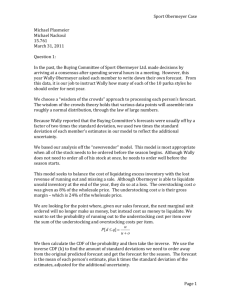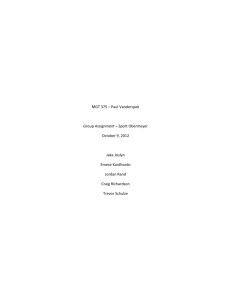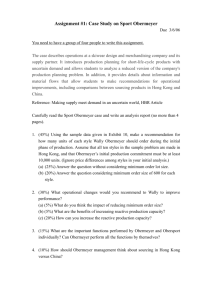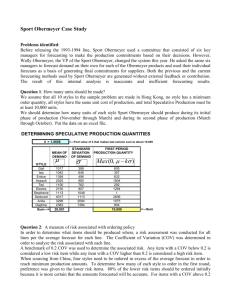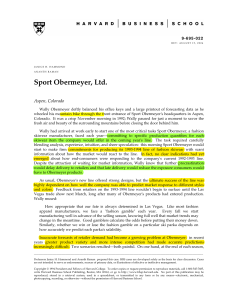Webinar: Developing a Demand-Driven Supply Chain Strategy
advertisement
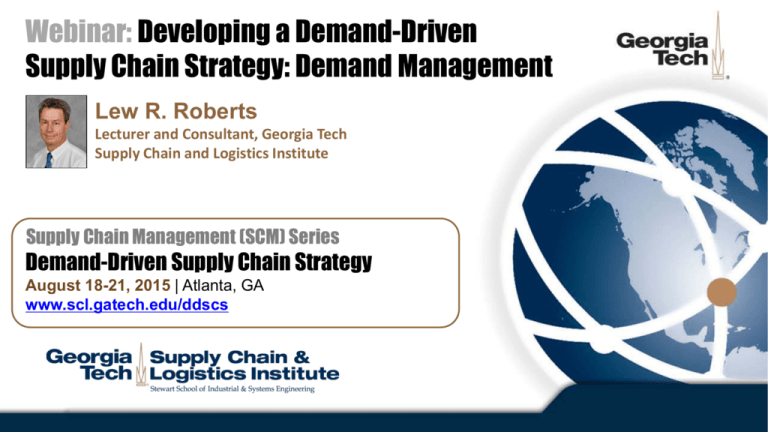
Webinar: Developing a Demand-Driven Supply Chain Strategy: Demand Management Lew R. Roberts Lecturer and Consultant, Georgia Tech Supply Chain and Logistics Institute Supply Chain Management (SCM) Series Demand-Driven Supply Chain Strategy August 18-21, 2015 | Atlanta, GA www.scl.gatech.edu/ddscs Demand Management - Agenda • Order Cycle: The Bigger Picture • Definitions of Demand Management • Demand Management and Business Strategy • Supply-Demand Misalignment • Functional vs. Innovative Products • Case Study: Sport Obermeyer Matching Supply and Demand is Challenging • Boeing Aircraft announced write-down of $2.6 billion in October, 1997 due to “raw material shortages, internal and supplier parts shortages, and productivity inefficiencies …” • “2nd quarter sales at U.S. Surgical Corporation declined 25%, resulting in a loss of $22 million. The sales and earnings shortfall is attributed to larger than anticipated inventories on the shelves of hospitals.” • “IBM sells out New Aptiva PC; Shortage may cost millions in potential revenue” • Campbell Soup’s winter marketing promotion caused a spike over and beyond the usual seasonal spike. Early production and inventory with overtime meant the cost of the excess production and inventory requirements far exceeded the revenue from the promotions. Source: Dr. Julie Swann, Georgia Tech - ISyE Total Order Cycle: A Customer’s Perspective Customer Places Order Warehouse Receipt 1 Key 1 6 2 Order Receipt 3 4 Order Shipped 2 Order Processing 3 5 Warehouse Pick & Pack 4 5 6 Example Times Order preparation and transmittal (orders sent) Order received and entered into the system Order processing Warehouse picking and packing Transit time Warehouse receiving and placing into storage Example Total Order Cycle Time 3 days 1 day 1 day 1 day 3 days 1 day 10 days Demand Management Defined Demand Management may be thought of as “focused efforts to estimate and manage customers’ demand, with the intention of using this information to shape operating decisions.” (Blackwell and Blackwell, SCMR, Fall, 1999). Desired objective is to further ability of supply chain firms to collaborate on activities relating to flows of product, services, information, and capital, to create value for the end user or consumer Example benefits of demand management: 6 Gathering and analyzing knowledge about consumers, their problems, and their unmet needs Identifying partners to perform functions needed in demand chain Shifting functions to demand chain member who man perform them most effectively and efficiently Sharing knowledge about consumers and end users with other demand chain firms Developing products and services that solve customers’ problems Developing and executing the best logistics methods to deliver products and services to consumers in the desired format Top Pressures for Improving Demand Management Processes 63% Poor forecast accuracy resulting in increased inventory costs 59% Dynamic consumer demand and volatile marketplace 39% Global supply chains requiring greater demand visibility and longer planning horizon 35% Retailer pressure to minimize stockouts 27% Pricing pressure and markdowns resulting in net reduction on gross margin 0% Source: AberdeenGroup, November 2006. 10% 20% 30% 40% 50% 60% 70% Barriers That Companies Face In Improving Demand Management Functional silos prevent ef f icient demand shaping 48% Lack of consensus f orecasting process internally w ithin the company 48% Many supply chains do not have normal demand distributions, making traditional f orecasting dif f icult 47% 45% Insuf f icient technology to support demand management needs 38% Inf lexible supply processes make it dif f icult to recover f rom poor demand plans 20% Dif f icult to get timely retail POS data 19% Previous demand management initiatives f ailed to deliver suf f icient improvement 10% Retailers are not collaborating w ith us 0% Source: AberdeenGroup, November 2006. 10% 20% 30% 40% 50% Question for Consideration What barriers have you experienced within your organization and/or do you foresee in improving demand management activity? 9 Demand Should Be The Driver of All Supply Chain Activity Demand Management: “Focused efforts to estimate and manage customers’ demand, with the intention of using this information to shape operating decisions” (Blackwell and Blackwell). Desired end result should be to create greater value for the end user or consumer. Ingram Micro’s Demand Chain Leadership Consumers/ End Users Multi-vendor Solutions Manufacturers Ingram Micro Resellers How Demand Management Supports Business Strategy Strategy Growth Strategy Examples of How to Use Demand Management Portfolio Strategy Positioning Strategy Investment Strategy Perform “what if” analyses on total industry volume to gauge how specific mergers and acquisitions might leverage market share Analyze industry supply/demand to predict changes in product pricing structure and market economics based on mergers and acquisitions Build staffing models for merged company using demand data Manage maturity of products in current portfolio to optimally time overlapping life cycles Create new-product development/introduction plans based on life cycle Balance combination of demand and risk for consistent “cash cows” with demand for new products Ensure diversification of product portfolio through demand forecasts Manage product sales through each channel based on demand and product economics Manage positioning of finished goods at appropriate distribution centers, to reduce working capital, based on demand Define capability to supply for each channel Manage capital investments, marketing expenditures, and R&D budgets based on demand forecasts of potential products and maturity of current products Determine whether to add manufacturing capacity Source: Jim Langabeer, “Aligning Demand Management With Business Strategy,” Supply Chain Management Review, May/June 2000. Time It Takes for Companies to Sense Changes in Demand 20% 20% 20% 15% 11% 10% 9% 10% 8% 8% 7% 60% of respondents 6% 5% s n M o 2 an th re M o Source: AberdeenGroup, November 2006. th W ee ks ks 58 4 W ee ks 3 W ee ks 2 W ee k W ee 1 s 35 D ay s D ay 12 H ou rs 0% Supply-Demand Misalignment: The Need for Demand Management Channel Orders True End Customer Demand Channel Fill and Phantom Demand Over-Supply Real Shortage Production Launch Date Returns/ Cancellations End of Life Source: Adapted from Accenture. True end customer demand Production cannot meet initial projected demand, resulting in real shortages Channel partners over-order in an attempt to meet demand and stock their shelves As supply catches up with demand, orders are canceled or returned Financial and production planning are not aligned with real demand; therefore, production continues As demand declines, all parties attempt to drain inventory to prevent write-down Functional vs. Innovative Products Functional Products Staples available in wide variety of retail outlets (e.g., grocery stores, gas stations, etc.) They do satisfy “basic” needs, which do not change much over time Have stable, predictable demand and long life cycles However, stability invites competition, leading to lower profit margins Innovative Products May be inherently innovative, or product-line extensions Very newness of innovative products makes demand for them difficult to predict, and product life cycles are often shorter Overall, require fundamentally different supply chain than do functional products Source: Marshall Fisher, “What is the Right Supply Chain For Your Product?”, Harvard Business Review, March-April, 1997. Functional vs. Innovative Products Aspects of Demand Product Life Cycle Contribution Margin Product Variety Average Margin of Error in Forecast at Time Production is Committed Average Stockout Rate Average Forced End-Of-Season Markdown as Percentage of Full Price Lead Time Required For Made-To-Order Products Functional (Predictable Demand) Innovative (Unpredictable Demand More Than 2 Years 3 Months to 1 Year 5% - 20% 20% - 60% Low (10 to 20 Variants Per Category) High (Often Millions of Variants Per Category) 10% 40% - 100% 1% - 2% 10% - 40% 0% 10% - 25% 6 Months to 1 Year 1 Day to 2 Weeks Source: Marshall Fisher, “What is the Right Supply Chain For Your Product?”, Harvard Business Review, March-April, 1997. Functional vs. Innovative Products Efficient Supply Chain Responsive Supply Chain Functional Products Innovative Products MATCH MISMATCH MISMATCH MATCH Source: Marshall Fisher, “What is the Right Supply Chain For Your Product?”, Harvard Business Review, March-April, 1997. Sport Obermeyer Case Study Sport Obermeyer (Case Analysis) Case Study: Sport Obermeyer Based in Aspen; Design/Manufacture Fashion Skiwear Market Through 800 Specialty Retailers in U.S. 95% of Products New Each Year … Continual Challenges of Demand Uncertainty Stockouts of “hot” items during selling season Markdowns of “dog” items at end of season Long Lead Times Forced Early Ordering of Products With More “Certain” Demand “Accurate Response” Cut Costs of Over- and Under-Production by One-Half, Increasing Profits by 60% Source: Marshall Fisher, “What is the Right Supply Chain For Your Product?”, Harvard Business Review, March-April, 1997. Case Study: Sport Obermeyer Highlights of Sport Obermeyer Annual Design-Production-Sales Process 18-20 Months February 1992 Design Process Begins for 93-94 Line March 1992 Las Vegas Show for 92-93 Line November 1992 Place First Production Run with Obersport March 1993 Las Vegas Show for 93-94 Line March 1993 Place Second Production Run with Obersport April-June 1993 Additional Retailer Orders Received October 1993 – Spring 1994 Ski Season for Design Process That Began in February 1992 – 18-20 months earlier Question for Consideration What do you see as being Sport Obermeyer’s key challenges? 21 Case Study: Sport Obermeyer Case Study: Sport Obermeyer Case Study: Sport Obermeyer Sport Obermeyer – Results Sport Obermeyer’s Decisions Model’s Decisions Total Production (Units) 121,432 124,805 Over-Production (Units) 25,094 22,036 Under-Production (Units) 7,493 792 Over-Production as Percent of Sales 1.74% 1.30% Under-Production as Percent of Sales 1.56% 0.18% Total Cost as Percent of Sales 3.30% 1.48% Webinar: Developing a Demand-Driven Supply Chain Strategy: Demand Management Questions? GeorgiaTechSCL @GTSCL Supply Chain Management (SCM) Series Georgia Tech Supply Chain & Logistics Institute Demand-Driven Supply Chain Strategy August 18-21, 2015 | Atlanta, GA www.scl.gatech.edu/ddscs http://www.youtube.com/gtscl
